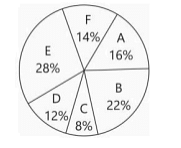If the selling price of 320 Web Cameras is equal to the cost price of 400 Web Cameras, then the percentage profit is :
- 12%
- 20%
- 40%
- 25%
The Correct Option is D
Solution and Explanation
Top Questions on Profit and Loss
- The selling price of a product is fixed to ensure 40% profit. If the product had cost 40% less and had been sold for 5 rupees less, then the resulting profit would have been 50%. The original selling price, in rupees, of the product is
- CAT - 2024
- Quantitative Aptitude
- Profit and Loss
- A company produces 'x' units of geometry boxes in a day. If the raw material of one geometry box costs ₹2 more than the square of the number of boxes produced in a day, the cost of transportation is half the number of boxes produced in a day, and the cost incurred on storage is ₹150 per day. The marginal cost (in ₹) when 70 geometry boxes are produced in a day is:
- CUET (UG) - 2024
- Mathematics
- Profit and Loss
- FS food stall sells only chicken biryani. If FS fixes a selling price of Rs. 160 per plate, 300 plates of biriyani are sold. For each increase in the selling price by Rs. 10 per plate, 10 fewer plates are sold. Similarly, for each decrease in the selling price by Rs. 10 per plate, 10 more plates are sold. FS incurs a cost of Rs. 120 per plate of biriyani, and has decided that the selling price will never be less than the cost price. Moreover, due to capacity constraints, more than 400 plates cannot be produced in a day.
If the selling price on any given day is the same for all the plates and can only be a multiple of Rs. 10, then what is the maximum profit that FS can achieve in a day? - An item is sold with a profit of \(40\%\). If the cost price is reduced by \(40\%\) and Rs. \(5\) are also reduced from it, then the profit will be increased to \(50\%\). Find the final cost price.
- CAT - 2024
- Quantitative Aptitude
- Profit and Loss
A furniture trader deals in tables and chairs. He has Rs. 75,000 to invest and a space to store at most 60 items. A table costs him Rs. 1,500 and a chair costs him Rs. 1,000. The trader earns a profit of Rs. 400 and Rs. 250 on a table and chair, respectively. Assuming that he can sell all the items that he can buy, which of the following is/are true for the above problem:
(A) Let the trader buy \( x \) tables and \( y \) chairs. Let \( Z \) denote the total profit. Thus, the mathematical formulation of the given problem is:
\[ Z = 400x + 250y, \]
subject to constraints:
\[ x + y \leq 60, \quad 3x + 2y \leq 150, \quad x \geq 0, \quad y \geq 0. \]
(B) The corner points of the feasible region are (0, 0), (50, 0), (30, 30), and (0, 60).
(C) Maximum profit is Rs. 19,500 when trader purchases 60 chairs only.
(D) Maximum profit is Rs. 20,000 when trader purchases 50 tables only.
Choose the correct answer from the options given below:
- CUET (UG) - 2024
- Mathematics
- Profit and Loss
Questions Asked in CMAT exam
- Ramesh invests 1,200 at 5% simple interest. How much additional money must he invest at 8% simple interest so that his total annual income will be equal to 6% of his total investment during this year?
- CMAT - 2024
- SI & CI
- Match List-l with List-ll:Choose the correct answer from the options given below:
List-I List-II (A) Alibi (I) This for that (B) Ex parte (II) Other (C) Lex loci (III) The law of the place (D) Quid pro quo (IV) From one side only - CMAT - 2024
- Idioms
- Study the pie chart and table and answer the questions
Store Respective ratio of number of linen kurtis to cotton kurtis sold A 7:5 B 5:6 C 3:2 D 5:3 E 4:3 F 7:3 
Number of kurtis (linen and cotton) sold by store D is what percent more than the number of linen kurtis sold by store B?- CMAT - 2024
- Pie Charts
- A, B, C, D, E, F, G, H and J are sitting around a circle facing the centre. C is third to the left of A. E is fourth to the right of A. D is fourth to the left of J, who is second to the right of A. F is third to the right of B. G is not an immediate neighbour of A. What is the H's position with respect to E?
- CMAT - 2024
- Logical and Analytical Reasoning Skills
- This particular scepticism of the reach of reasoning ____1 ____ not yield nor (as Appiah makes clear) is it intended to yield any ground for not using reason to the extent one can, in ____ 2 ____ the idea of justice or any other notion of social relevance,such as identity.Nor does it undermine the case for our trying to persuade each other to scrutinize our respective conclusions.It is also important to note that what may appear to others as clear examples of 'unreason' may not always be exactly that.Reasoned discussion can accommodate conflicting positions that may appear to others to be 'unreasoned prejudice,without this being quite the case.There is no compulsion, as is sometimes____3____to eliminate every reasoned alternative except exactly one.
In the above passage there are blanks, each of which has been numbered.Find out the appropriate option in each case to replace the given numbers.
Pick the appropriate replacement for (II)- CMAT - 2024
- Reading Comprehension



